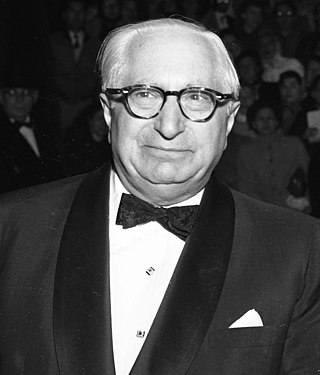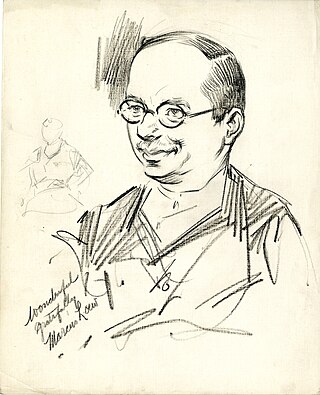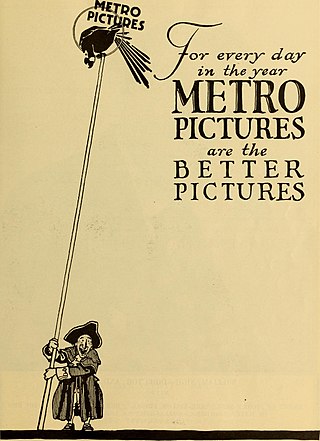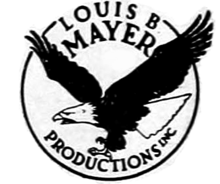
Cecil Blount DeMille was an American filmmaker and actor. Between 1914 and 1958, he made 70 features, both silent and sound films. He is acknowledged as a founding father of American cinema and the most commercially successful producer-director in film history. His films were distinguished by their epic scale and by his cinematic showmanship. His silent films included social dramas, comedies, Westerns, farces, morality plays, and historical pageants. He was an active Freemason and member of Prince of Orange Lodge #16 in New York City.

Metro-Goldwyn-Mayer Studios, Inc., is an American media company specializing in film and television production and distribution. Founded on April 17, 1924, and based in Beverly Hills, California, it is owned by the Amazon MGM Studios subsidiary of Amazon.

Lionel Barrymore was an American actor of stage, screen and radio as well as a film director. He won an Academy Award for Best Actor for his performance in A Free Soul (1931), and is known to modern audiences for the role of villainous Mr. Potter in Frank Capra's 1946 film It's a Wonderful Life.
Margaret Booth was an American film editor. In a career lasting seven decades, Booth was most associated with Metro-Goldwyn-Mayer (MGM).

Major film studios are production and distribution companies that release a substantial number of films annually and consistently command the significant share of box office revenue in a given market. In the American and international markets, the major film studios, often known simply as the majors or the Big Five studios, are commonly regarded as the five diversified media conglomerates whose various film production and distribution subsidiaries collectively command approximately 80 to 85% of U.S. box office revenue. The term may also be applied more specifically to the primary motion picture business subsidiary of each respective conglomerate.

Louis Burt Mayer was a Canadian-American film producer and co-founder of Metro-Goldwyn-Mayer studios (MGM) in 1924. Under Mayer's management, MGM became the film industry's most prestigious movie studio, accumulating the largest concentration of leading writers, directors, and stars in Hollywood.

Samuel Goldwyn, also known as Samuel Goldfish, was a Polish-born American film producer. He was best known for being the founding contributor and executive of several motion picture studios in Hollywood. He was awarded the 1973 Golden Globe Cecil B. DeMille Award, the Irving G. Thalberg Memorial Award (1947) and the Jean Hersholt Humanitarian Award (1958).

Goldwyn Pictures Corporation was an American motion picture production company that operated from 1916 to 1924 when it was merged with two other production companies to form the major studio, Metro-Goldwyn-Mayer. It was founded on November 19, 1916, by Samuel Goldfish, an executive at Lasky's Feature Play Company, and Broadway producer brothers Edgar and Archibald Selwyn, using an amalgamation of both last names to name the company.

The 1st Academy Awards ceremony, presented by the Academy of Motion Picture Arts and Sciences (AMPAS) and hosted by AMPAS president Douglas Fairbanks, honored the best films from 1 August 1927 to 31 July 1928 and took place on May 16, 1929, at a private dinner held at the Hollywood Roosevelt Hotel in Los Angeles, California. Tickets cost $5 ; 270 people attended the event, which lasted 15 minutes. It is the only Academy Awards ceremony not broadcast on either radio or television; a radio broadcast was introduced for the 2nd Academy Awards.

William B. Goetz was an American film producer and studio executive. Goetz was one of the founders of Twentieth Century Pictures, and later served as vice president of 20th Century Fox after the studio's merger with the Fox Film Company. At Universal-International, he served as the head of production from 1946 until 1953.

Twentieth Century Pictures, Inc. was an independent Hollywood motion picture production company created in 1933 by Joseph Schenck and Darryl F. Zanuck from Warner Bros. Financial backing came from Schenck's younger brother Nicholas Schenck, president of Loew's, the theater chain that owned Metro-Goldwyn-Mayer (MGM), Louis B. Mayer of MGM, who wanted a position for his son-in-law, William Goetz, Bank of America and Herbert J. Yates owner of the film processing laboratory Consolidated Film Industries, who later founded Republic Pictures Corporation in 1935. The company product was distributed by United Artists (UA), and leased space at Samuel Goldwyn Studios.

Marcus Loew was an American business magnate and a pioneer of the motion picture industry who formed Loew's Theatres and the Metro-Goldwyn-Mayer film studio (MGM).

Metro Pictures Corporation was a motion picture production company founded in early 1915 in Jacksonville, Florida. It was a forerunner of Metro-Goldwyn-Mayer. The company produced its films in New York, Los Angeles, and sometimes at leased facilities in Fort Lee, New Jersey. It was purchased in 1919.

The Sony Pictures Studios is an American television and film studio complex located in Culver City, California at 10202 West Washington Boulevard and bounded by Culver Boulevard (south), Washington Boulevard (north), Overland Avenue (west) and Madison Avenue (east). Founded in 1912, the facility is currently owned by Sony Pictures and houses the division's film studios, such as Columbia Pictures, TriStar Pictures, and Screen Gems. The complex was the original studios of Metro-Goldwyn-Mayer from 1924 to 1986 and Lorimar-Telepictures from 1986 to 1989.
Poverty Row is a slang term used to refer to Hollywood films produced from the 1920s to the 1950s by small B movie studios. Although many of them were based on today's Gower Street in Hollywood, the term did not necessarily refer to any specific physical location, but was rather a figurative catch-all for low-budget films produced by these lower-tier studios.
Samuel Goldwyn Productions was an American film production company founded by Samuel Goldwyn in 1923, and active through 1959. Personally controlled by Goldwyn and focused on production rather than distribution, the company developed into the most financially and critically successful independent production company in Hollywood's Golden Age.

The Merry Widow is a 1925 American silent romantic drama/black comedy film directed and written by Erich von Stroheim. Released by Metro-Goldwyn-Mayer, the film stars Mae Murray, John Gilbert, Roy D'Arcy, and Tully Marshall, with pre-fame uncredited appearances by Joan Crawford and Clark Gable.
Three Wise Fools is a 1923 American silent drama film directed by King Vidor. A print of the film exists at the Cinematheque Royale de Belgique. It showed in Germany at the Union-Theater Nollendorf, Berlin, on November 10, 1924. The cinema was built in 1913 by Joe Goldsoll, who was president of Goldwyn Pictures from 1922-1924.

Manuel Granada was an Argentine actor who appeared in American, Spanish, Argentine and Mexican films. For the first half of his career, he worked under the names Paul Ellis and Manuel Granado.

Benjamin Thau was an American businessman who became vice-president of the Hollywood film studio Metro-Goldwyn-Mayer (MGM), a subsidiary of the Loew's theater chain. From 1928 he was in charge of casting, in the business of discovering and developing talented performers. He was known for his quiet and calming influence with often temperamental stars. Towards the end of his career he was head of the studio from 1956 to 1958.















